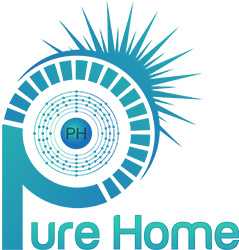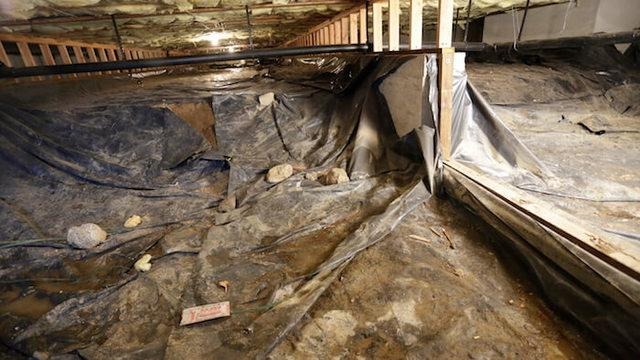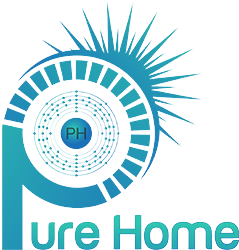Common Crawl Space Problems
A crawl space may not be a part of your home that you think about often, but it plays a crucial role in the overall health of your property. Unfortunately, this often overlooked area can be prone to a variety of issues such as mold growth, excess moisture, and standing water. These problems can arise due to poor ventilation, inadequate drainage, or plumbing leaks.
Ignoring these issues can lead to structural damage, health risks, and even a decrease in property value. With proper insulation, regular maintenance, and waterproofing, you can prevent these problems from occurring. If you already have these issues, it is essential to address the source of the problem, hire a professional for crawl space mold remediation, and take preventative measures for the future.
In this article, we will delve deeper into the common problems in a crawl space, their causes, consequences of ignoring them, and how to prevent and address these issues effectively.
Key Takeaways:
- Mold, excess moisture, and standing water are common problems in crawl spaces that can lead to structural damage, health risks, and decrease in property value.
- These problems are often caused by poor ventilation, inadequate drainage, and plumbing leaks in the crawl space.
- To prevent these problems, proper insulation, regular maintenance, and waterproofing should be implemented, and if already present, addressing the source of the problem and hiring professionals for remediation is important.
What is a Crawl Space?
A crawl space is a shallow, unfinished area within a building between the ground and the first floor, typically not tall enough for a person to stand up in.
Despite being confined in height, crawl spaces serve a crucial function in buildings. These spaces act as a buffer between the foundation of the structure and the ground, helping to mitigate moisture issues and provide easier access to essential components like wiring or plumbing.
Proper ventilation is essential in crawl spaces to prevent mold growth and maintain healthy indoor air quality. Generally located underneath the house, crawl spaces might exhibit features like dirt floors, concrete slab, or even gravel surfaces.
Why is a Crawl Space Important?
A crawl space is vital for providing access to essential components of a building such as wiring, plumbing, and ventilation systems, facilitating maintenance and repairs.
Crawl spaces play a critical role in safeguarding infrastructure elements like insulation, pest control barriers, and HVAC ductwork, ensuring they remain functional and protected. These spaces also enable easy monitoring of potential issues, promoting early detection and mitigation of problems, ultimately enhancing the overall longevity and efficiency of a building’s systems.
The accessibility provided by crawl spaces allows for swift interventions during emergencies, preventing extensive damages and minimizing repair costs. Maintaining a well-designed and properly maintained crawl space is integral to the structural integrity and functionality of a building.
What are the Common Problems in a Crawl Space?
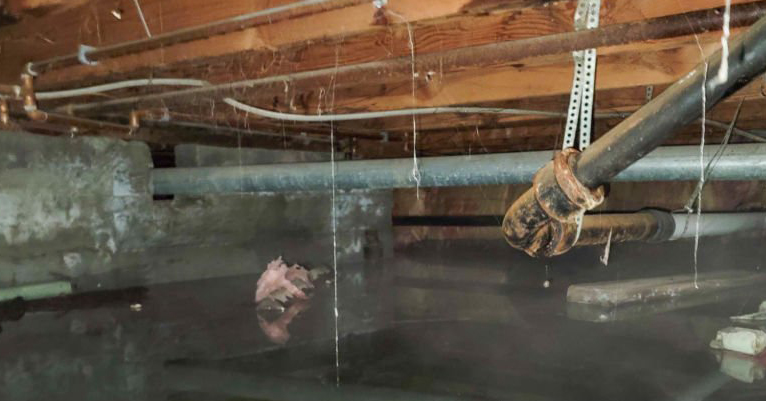
Common problems in a crawl space include issues like mold growth, excess moisture accumulation, and the presence of standing water, which can lead to structural and health-related concerns.
When mold growth goes unchecked, it can spread rapidly throughout the crawl space, causing not only a foul odor but also potential respiratory issues for the inhabitants of the home. Excess moisture accumulation is a breeding ground for mold and can also weaken the structural integrity of the property over time, leading to costly repairs. Standing water, if left unaddressed, can seep into the foundation, causing further damage and potentially affecting the overall stability of the building.
Mold Growth
Mold growth in a crawl space can pose serious health risks due to the release of allergens and toxins that can trigger respiratory conditions like asthma.
When left unchecked, mold in crawl spaces can quickly spread throughout a home, affecting indoor air quality and potentially leading to a range of health problems. The presence of mold can exacerbate allergies and respiratory issues, causing symptoms such as coughing, wheezing, and throat irritation. Mold spores released into the air can also be inhaled, leading to respiratory infections and aggravating conditions like bronchitis or sinusitis. Individuals with compromised immune systems or pre-existing respiratory conditions are particularly vulnerable to the harmful effects of mold exposure.
Excess Moisture
Excess moisture in a crawl space can lead to the deterioration of structural components such as joists, beams, and support posts, compromising the overall stability of the building.
When moisture infiltrates the crawl space, it creates a conducive environment for wood rot, mold growth, and insect infestation. Joists, beams, and support posts, essential elements for the structural integrity of a building, become susceptible to decay and weakening under prolonged exposure to high humidity levels.
Rotting wood weakens the load-bearing capacity of these components, undermining the foundation’s ability to support the weight of the structure above. In severe cases, excessive moisture can lead to sagging floors, uneven settling, and even structural collapse.
Standing Water
The presence of standing water in a crawl space can attract pests like rodents and termites, leading to potential infestations and damage to the foundation of the building.
The stagnant water provides an ideal breeding ground for mosquitoes and other insects, further exacerbating the pest-related issues. The excess moisture can also compromise the structural integrity of the foundation, leading to cracks, mold growth, and wood decay. These conditions not only attract pests but also create a conducive environment for them to thrive, posing a significant threat to the overall stability of the building. Addressing water accumulation promptly is essential to prevent these detrimental effects on the property.
What Causes these Problems in a Crawl Space?
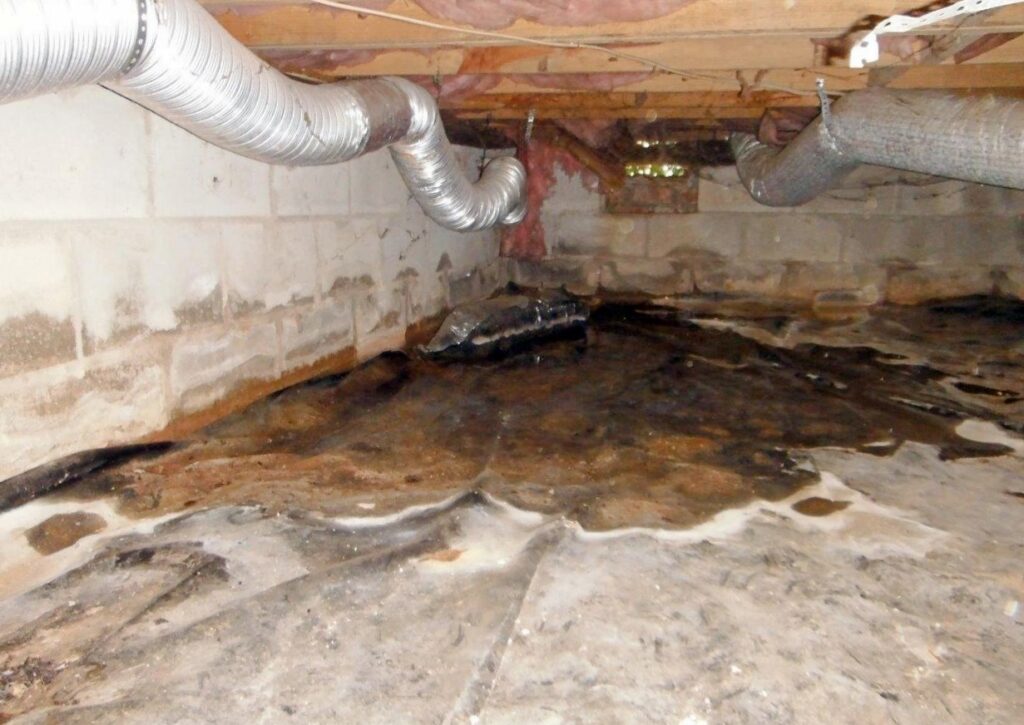
Common causes of crawl space standing water and other problems include factors like poor ventilation, inadequate drainage systems, and plumbing leaks that contribute to mold growth and moisture accumulation.
Improper ventilation in crawl spaces leads to stagnant air, trapping moisture and creating a breeding ground for mold and mildew. This lack of airflow allows humidity to build up, leading to damp conditions which encourage the growth of mold. Inadequate drainage systems allow water to seep into the crawl space, further exacerbating moisture issues. Additionally, plumbing leaks can go unnoticed in crawl spaces for extended periods, causing ongoing water damage and moisture problems. All these combined factors create an environment ripe for mold and structural damage.
Poor Ventilation
Inadequate ventilation in a crawl space can trap moisture and lead to the buildup of harmful substances, contributing to the spread of diseases and compromising indoor air quality.
When there is poor ventilation in a crawl space, the stagnant air becomes a breeding ground for mold and mildew due to the high moisture levels, which can compromise the structural integrity of insulation and even attract pests seeking a damp environment. This can lead to a decreased thermal efficiency of the insulation, resulting in higher energy bills.
The trapped pollutants in the confined space can circulate throughout the home, worsening respiratory conditions and exposing occupants to potential health hazards. Ensuring proper ventilation in crawl spaces is crucial for maintaining a healthy living environment and preventing the proliferation of allergens and pathogens.
Inadequate Drainage
Lack of proper drainage mechanisms in a crawl space can result in water accumulation, leading to foundation issues like cracks and structural instability.
When water collects in the crawl space without efficient ways to drain, it can seep into the foundation, causing cracks that weaken the structural integrity of the building. Moisture trapped in the crawl space can also create a hospitable environment for mold and mildew growth, posing health risks to inhabitants.
Prolonged exposure to moisture can lead to wood rot in the floor joists and beams, compromising the overall stability of the structure. In severe cases, inadequate drainage can even result in the sinking or shifting of the foundation, requiring costly repairs to rectify the damage caused.
Plumbing Leaks
Leaks in plumbing systems within a crawl space can cause damage to wiring, insulation, and other structural components, creating a conducive environment for mold growth and moisture issues.
When left unchecked, these leaks can compromise the structural integrity of your home or building, leading to costly repairs and potential safety hazards. Water seepage from leaking pipes can saturate the soil beneath the crawl space, weakening the foundation over time. This excess moisture not only fosters mold growth but also deteriorates insulation, reducing its effectiveness and increasing energy costs. Damp conditions encourage wood rot, threatening the stability of floor joists and beams. The insidious nature of these issues underscores the importance of promptly addressing plumbing leaks within crawl spaces.
What are the Consequences of Ignoring these Problems?
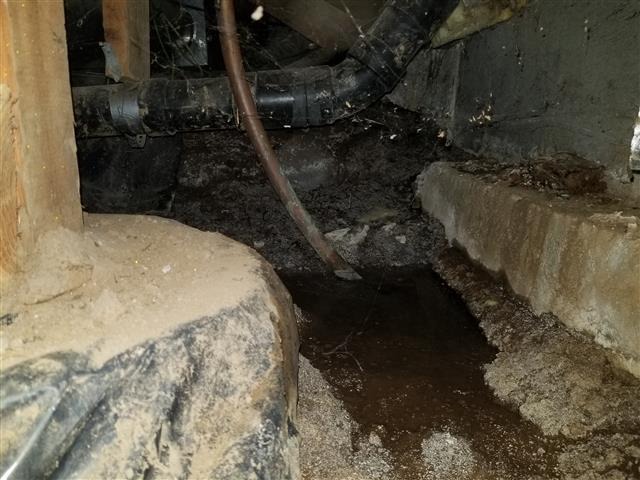
Neglecting crawl space issues can result in severe consequences such as structural damage, health risks from mold exposure, and a decrease in property value due to unresolved problems.
When crawl space issues are left untreated, the structural integrity of the entire property is at risk. Cracks in the foundation, sagging floors, and compromised walls can all stem from neglecting these problems.
The health hazards posed by mold thriving in dark, damp crawl spaces cannot be understated. Mold spores can easily spread and contaminate the air, leading to respiratory issues and allergies for the occupants of the property.
The ripple effect on property value is clear. Potential buyers are often wary of homes with undisclosed or poorly managed crawl space issues, impacting the overall marketability and value of the property.
Structural Damage
Untreated crawl space issues can lead to structural damage, compromising the stability of support posts, beams, and joists, especially in cases of termite infestations.
When crawl space problems are left unattended, the foundational elements of a building become vulnerable to deterioration. The support posts that bear the weight of the structure may weaken, risking a cascading effect on the overall stability. Similarly, beams supporting the upper levels can sag or crack under the pressure of compromised crawl space conditions. The joists that form the framework of floors and ceilings may start to rot or warp, posing serious structural concerns.
Health Risks
Ignoring crawl space problems can pose health risks to occupants, including exposure to diseases, allergens, and respiratory issues, affecting overall well-being.
One of the major health hazards that can stem from untreated crawl space issues is the potential spread of infectious diseases. Pathogens like mold, bacteria, and viruses thrive in dark, damp environments commonly found in crawl spaces, making it easy for them to spread to the rest of the living space. This can lead to occupants falling ill, experiencing symptoms ranging from respiratory problems to skin infections.
The presence of allergens such as dust mites and pest droppings can trigger allergic reactions, exacerbating asthma and other respiratory conditions. The cumulative impact of these health concerns on occupant well-being cannot be overstated, underscoring the importance of addressing crawl space issues promptly.
Decrease in Property Value
Unresolved crawl space problems can lead to a decrease in property value due to pest infestations, insulation damage, and structural compromise, deterring potential buyers.
When pests such as termites or rodents infiltrate the crawl space, they can cause extensive damage to the wooden structures, posing a serious threat to the home’s integrity. This not only affects the aesthetics but also the safety of the property. Proper insulation in the crawl space is crucial for maintaining energy efficiency and preventing moisture-related issues that can lead to mold growth and further deterioration. Structural concerns arising from neglected crawl spaces can escalate, potentially causing major repair expenses for homeowners and lowering the property’s overall value.
How Can These Problems Be Prevented?
Preventing crawl space problems involves measures like ensuring proper insulation, conducting regular maintenance checks, and implementing waterproofing solutions to mitigate moisture issues.
Regarding insulation techniques, using closed-cell spray foam can be highly effective in creating a barrier against moisture and temperature fluctuations. Regular maintenance protocols should include checking for signs of pests, mold, and structural damage, and addressing them promptly.
For waterproofing methods, installing a vapor barrier on the ground and walls can help prevent moisture from seeping into the crawl space. Ensuring proper drainage around the perimeter of the crawl space is crucial in diverting water away from the area.
Proper Insulation
Effective insulation in a crawl space can protect wiring from damage, prevent condensation buildup, and reduce the risk of diseases associated with mold and mildew.
Insulating a crawl space is crucial for maintaining a healthy indoor environment as well as ensuring the structural integrity of a building. Proper insulation acts as a barrier against moisture infiltration, which can lead to the growth of mold and mildew. Mold spores can cause respiratory issues and aggravate allergies, making it essential to create a moisture-resistant environment.
Regular Maintenance
Scheduled maintenance of crawl spaces involves inspecting joists, beams, and monitoring for signs of moisture buildup to address potential issues proactively before they escalate.
Regular upkeep of crawl spaces is essential for preserving the structural integrity of a building and ensuring a healthy living environment. By examining joists and beams during maintenance checks, one can detect early warning signs of structural damage and prevent costly repairs in the future. Moisture detection is crucial as it can lead to mold growth, wood decay, and attract pests, posing health hazards and compromising the stability of the structure.
Waterproofing
Waterproofing solutions in crawl spaces can help prevent standing water issues, deter termite infestations, and safeguard the structural integrity of the building against water damage.
By investing in proper waterproofing for crawl spaces, homeowners can significantly reduce the risk of mold growth due to excess moisture, which not only affects the indoor air quality but can also lead to health issues. Waterproofing acts as a barrier against pests like ants, cockroaches, and rodents, creating an inhospitable environment for them to thrive in the crawl space. This added protection not only ensures the longevity of the building’s structure but also contributes to a healthier living environment for occupants.
What to Do If You Already Have These Problems?
If you are already facing crawl space issues, it is crucial to address the root cause of the problem, seek professional remediation services, and implement preventive measures to avoid future recurrence.
Identifying the underlying issues causing moisture, mold, or structural damage in the crawl space is essential for effective long-term solutions.
Relying on experienced professionals for thorough inspections and tailored remediation plans can ensure a comprehensive resolution to the existing problems.
Incorporating routine maintenance checks and moisture control strategies can significantly reduce the likelihood of recurring crawl space issues in the future.
Address the Source of the Problem
Identifying and addressing the source of crawl space problems, such as mold growth, is essential to prevent recurring issues and mitigate health risks associated with diseases.
When mold is left unchecked in crawl spaces, it can lead to a variety of health problems, like respiratory issues and allergies that are mold related. Plus health concerns, mold infestations can also compromise the structural integrity of a building over time. By focusing on mold remediation and eliminating the conditions that promote mold growth, homeowners can create a healthier living environment and protect their property. Prioritizing source elimination not only addresses the immediate issue but also prevents future problems, saving both time and money in the long run.
Hire a Professional for Remediation
Engaging a professional service for crawl space remediation can effectively address pest infestations, repair insulation damage, and restore the crawl space to a safe and functional condition.
Professional remediation services bring a myriad of benefits beyond just pest control and insulation restoration. They possess the expertise required to comprehensively assess and tackle any underlying issues in your crawl space. Through meticulous inspection, they can identify potential water damage, mold growth, or structural concerns that could compromise the integrity of your home. Their proactive approach not only resolves current issues but also prevents future problems from arising, ensuring long-term peace of mind for homeowners. By entrusting professionals with crawl space remediation, you are investing in the longevity and safety of your property.
Take Preventative Measures for the Future
Implementing preventative measures like addressing standing water issues and pest control can help safeguard your crawl space against future problems and maintain the integrity of your property.
Preventive actions in crawl spaces play a crucial role in ensuring a healthy environment within your home. By managing water effectively, you can prevent issues like mold growth and structural damage. Pest prevention strategies also deter unwanted critters from infiltrating your crawl space, which could lead to damage and health hazards. Regular inspections and maintenance routines are essential for identifying potential problems early and addressing them proactively. Taking these long-term measures can save you from costly repairs and preserve the value of your property in the years to come.
Frequently Asked Questions about Common Crawl Space Problems
What are some common crawl space problems?
Some common crawl space problems include mold growth, excess moisture, and standing water. These issues can cause damage to your home and pose a threat to your health.
How does mold grow in crawl spaces?
Mold grows in crawl spaces due to the presence of moisture and organic materials, such as wood or insulation. This creates a perfect environment for mold to thrive and spread.
What are the dangers of having mold in your crawl space?
Mold in crawl spaces can lead to various health issues, including respiratory problems, allergies, and skin irritation. It can also weaken the structural integrity of your home and cause unpleasant odors.
Why is excess moisture a problem in crawl spaces?
Excess moisture in crawl spaces can lead to various problems, such as rotting wood, rusted pipes, and damage to insulation and electrical wiring. It can also create a breeding ground for mold and attract pests.
How can standing water in crawl spaces be problematic?
Standing water in crawl spaces can attract insects and pests, cause structural damage, and contribute to mold growth. It can also create an unpleasant musty smell and make your home uncomfortable.
What can be done to prevent common crawl space problems?
Regular maintenance and proper insulation can help prevent common crawl space problems. Ensuring proper ventilation and addressing any leaks or moisture issues can also help keep your crawl space dry and free of mold.
